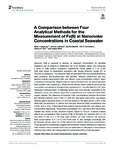A Comparison between Four Analytical Methods for the Measurement of Fe(II) at Nanomolar Concentrations in Coastal Seawater
| dc.contributor.author | Hopwood, MJ | |
| dc.contributor.author | Birchill, AJ | |
| dc.contributor.author | Gledhill, M | |
| dc.contributor.author | Achterberg, EP | |
| dc.contributor.author | Klar, JK | |
| dc.contributor.author | Milne, Angela | |
| dc.date.accessioned | 2017-07-12T14:43:53Z | |
| dc.date.accessioned | 2017-08-11T11:39:06Z | |
| dc.date.available | 2017-07-12T14:43:53Z | |
| dc.date.available | 2017-08-11T11:39:06Z | |
| dc.date.issued | 2017-06-29 | |
| dc.identifier.issn | 2296-7745 | |
| dc.identifier.issn | 2296-7745 | |
| dc.identifier.other | ARTN 192 | |
| dc.identifier.uri | http://hdl.handle.net/10026.1/9793 | |
| dc.description.abstract |
Dissolved Fe(II) in seawater is deemed an important micronutrient for microbial organisms, but its analysis is challenging due to its transient nature. We conducted a series of Fe(II) method comparison experiments, where spikes of 5 to 31 nM Fe(II) were added to manipulated seawaters with varying dissolved oxygen (37 to 156 μM) concentrations. The observed Fe(II) concentrations from four analytical methods were compared: spectrophotometry with ferrozine, stripping voltammetry, and flow injection analysis using luminol (with, and without, a pre-concentration column). Direct comparisons between the different methods were undertaken from the derived apparent Fe(II) oxidation rate constant (k1). Whilst the two luminol based methods produced the most similar concentrations throughout the experiments, k1 was still subject to a 20-30% discrepancy between them. Contributing factors may have included uncertainty in the calibration curves, and different responses to interferences from Co(II) and humic/fulvic organic material. The difference in measured Fe(II) concentrations between the luminol and ferrozine methods, from 10 min-2 h after the Fe(II) spikes were added, was always relatively large in absolute terms (>4 nM) and relative to the spike added (>20% of the initial Fe(II) concentration). k1 derived from ferrozine observed Fe(II) concentrations was 3-80%, and 4-16%, of that derived from luminol observed Fe(II) with, and without, pre-concentration respectively. The poorest comparability of k1 was found after humic/fulvic material was added to raise dissolved organic carbon to 120 μM. A luminol method without pre-concentration then observed Fe(II) to fall below the detection limit (<0.49 nM) within 10 min of a 17 nM Fe(II) spike addition, yet other methods still observed Fe(II) concentrations of 2.7 to 3.7 nM 30 min later. k1 also diverged accordingly with the ferrozine derived value 4% of that derived from luminol without pre-concentration. These apparent inconsistencies suggest that some inter-dataset differences in measured Fe(II) oxidation rates in natural waters may be attributable to differences in the analytical methods used rather than arising solely from substantial shifts in Fe(II) speciation. | |
| dc.format.extent | 192- | |
| dc.language.iso | en | |
| dc.publisher | Frontiers Media | |
| dc.relation.replaces | http://hdl.handle.net/10026.1/9614 | |
| dc.relation.replaces | 10026.1/9614 | |
| dc.subject | Fe(II) methods | |
| dc.subject | iron | |
| dc.subject | luminol chemiluminescence | |
| dc.subject | ferrozine | |
| dc.subject | voltammetry | |
| dc.title | A Comparison between Four Analytical Methods for the Measurement of Fe(II) at Nanomolar Concentrations in Coastal Seawater | |
| dc.type | journal-article | |
| dc.type | Journal Article | |
| plymouth.author-url | https://www.webofscience.com/api/gateway?GWVersion=2&SrcApp=PARTNER_APP&SrcAuth=LinksAMR&KeyUT=WOS:000457690600192&DestLinkType=FullRecord&DestApp=ALL_WOS&UsrCustomerID=11bb513d99f797142bcfeffcc58ea008 | |
| plymouth.issue | JUN | |
| plymouth.volume | 4 | |
| plymouth.publication-status | Published | |
| plymouth.journal | Frontiers in Marine Science | |
| dc.identifier.doi | 10.3389/fmars.2017.00192 | |
| plymouth.organisational-group | /Plymouth | |
| plymouth.organisational-group | /Plymouth/Faculty of Science and Engineering | |
| plymouth.organisational-group | /Plymouth/Faculty of Science and Engineering/School of Geography, Earth and Environmental Sciences | |
| plymouth.organisational-group | /Plymouth/REF 2021 Researchers by UoA | |
| plymouth.organisational-group | /Plymouth/REF 2021 Researchers by UoA/UoA07 Earth Systems and Environmental Sciences | |
| plymouth.organisational-group | /Plymouth/Research Groups | |
| plymouth.organisational-group | /Plymouth/Research Groups/BEACh | |
| plymouth.organisational-group | /Plymouth/Users by role | |
| plymouth.organisational-group | /Plymouth/Users by role/Academics | |
| dcterms.dateAccepted | 2017-06-06 | |
| dc.identifier.eissn | 2296-7745 | |
| dc.rights.embargoperiod | No embargo | |
| rioxxterms.versionofrecord | 10.3389/fmars.2017.00192 | |
| rioxxterms.licenseref.uri | http://www.rioxx.net/licenses/all-rights-reserved | |
| rioxxterms.licenseref.startdate | 2017-06-29 | |
| rioxxterms.type | Journal Article/Review | |
| plymouth.funder | Shelf sources of iron to the ocean::NERC | |
| plymouth.oa-location | http://journal.frontiersin.org/article/10.3389/fmars.2017.00192/full |


